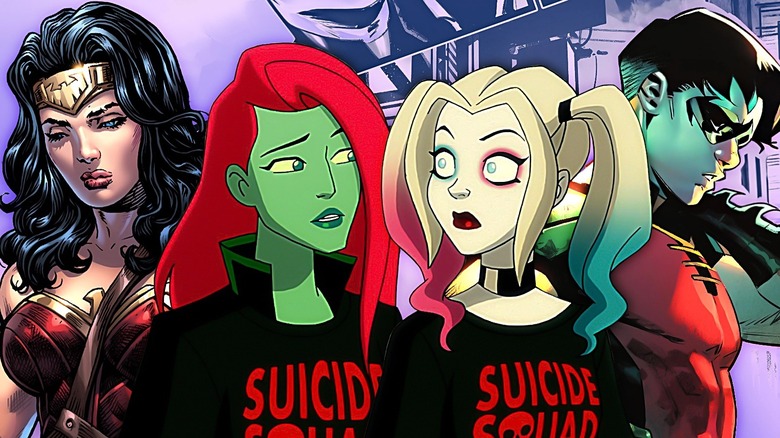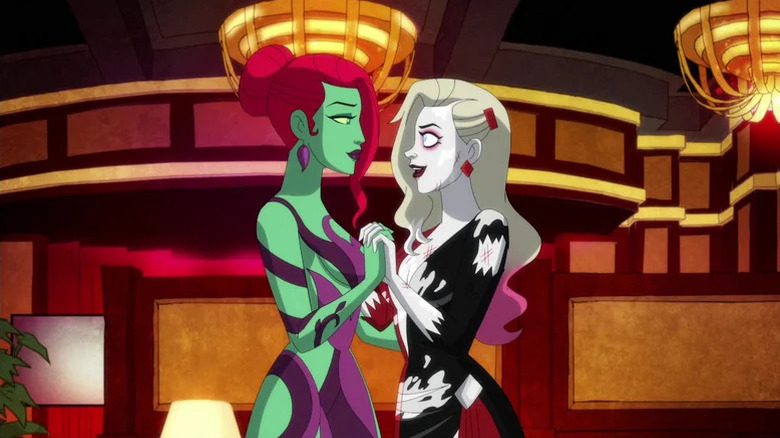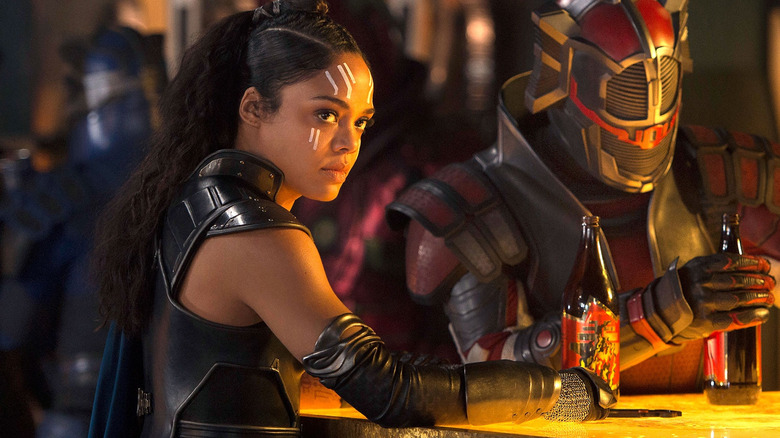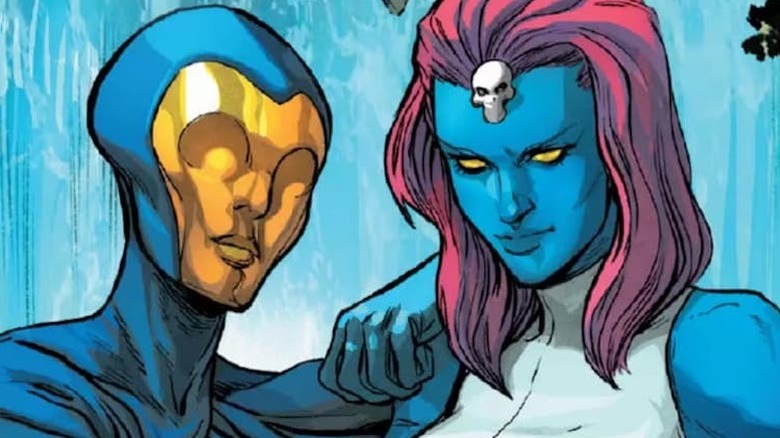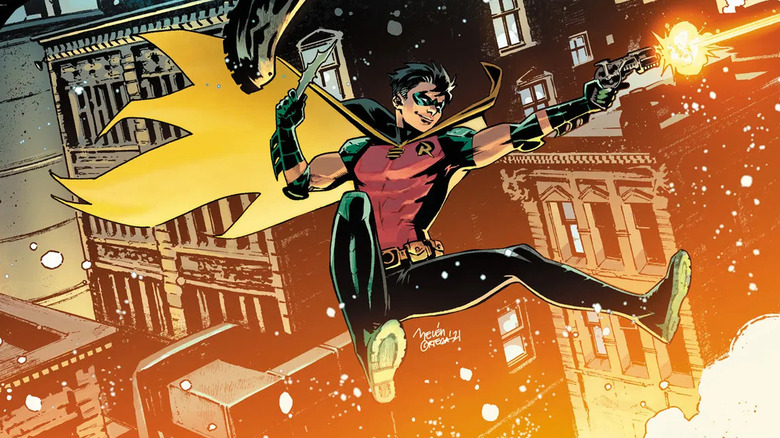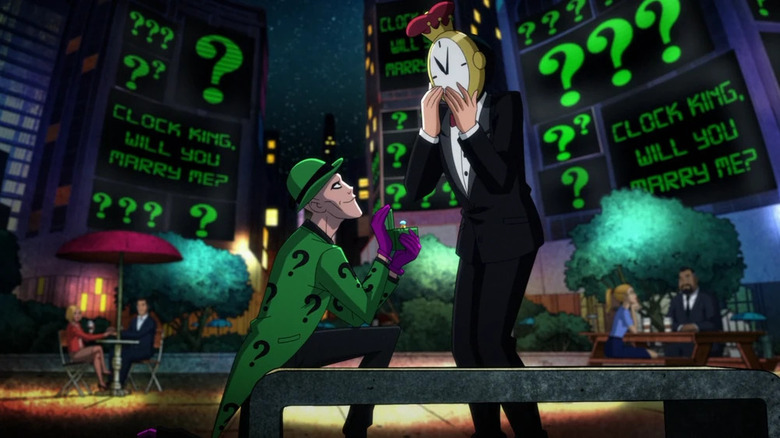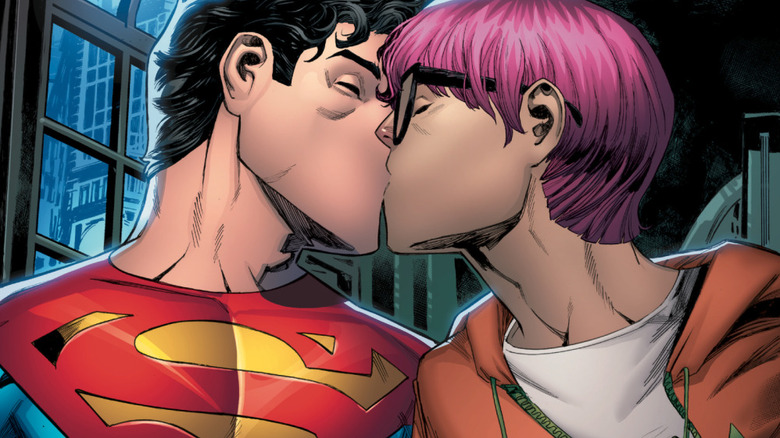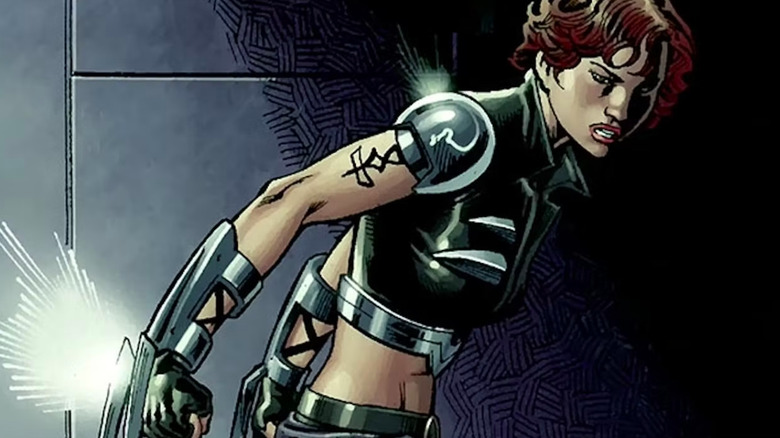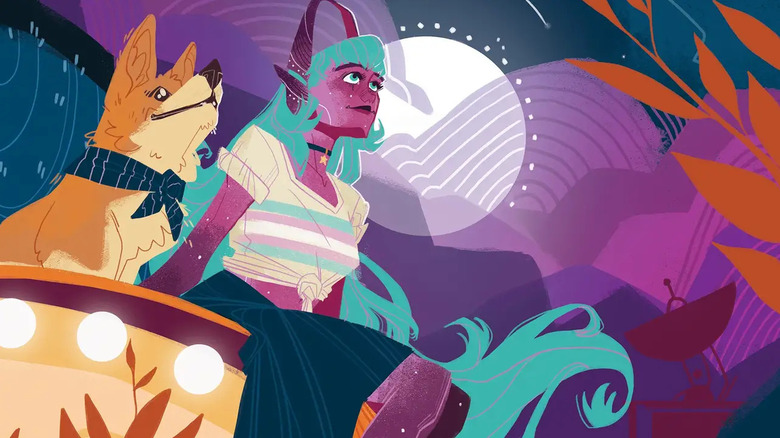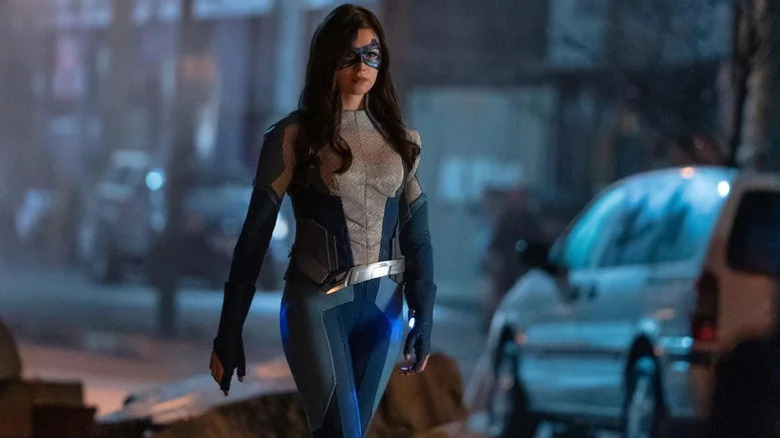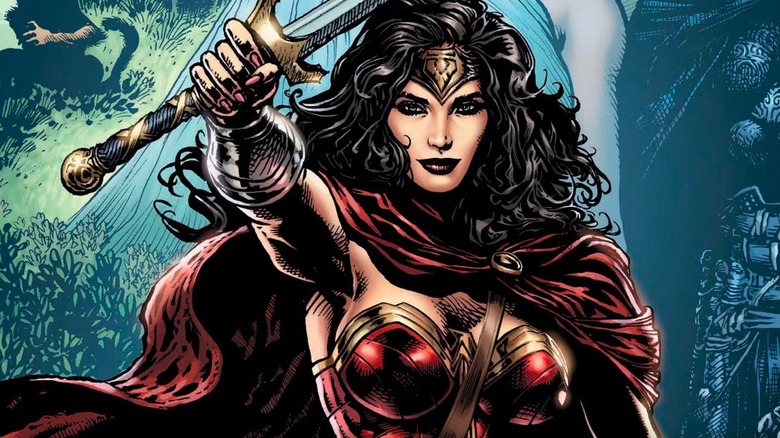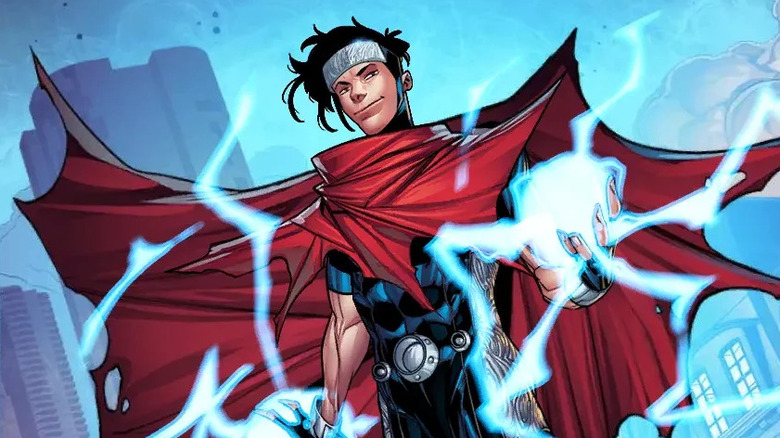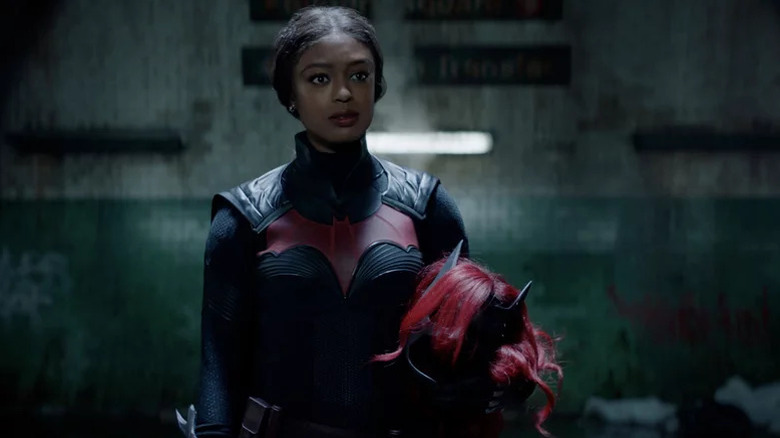12 LGBTQIA+ Superheroes And Villains You Might Not Know About
Though they are now most associated with massive blockbusters, superheroes were politically-minded creations from the start, and the early heroes were more subversive than we give them credit for. Wonder Woman was created by psychologist William Moulton Marston, who lived together with two women some think were also romantically involved with each other. He explicitly created Wonder Woman to teach girls and boys about the importance of feminism and was inspired by first-wave activists and artists.
On the cover of the first issue of "Captain America Comics," the titular hero is shown punching Hitler in the face. Creators Joe Simon and Jack Kirby created the character as an anti-Nazi figure, as Simon strongly opposed non-interventionism during World War II and wanted the hero to reflect these views. That continues today, as many have also read Marvel's "Civil War" series as a direct commentary on the Patriot Act.
Indeed, superheroes began as a way to speak to everyday people, though many of their ideals were corrupted over time by money and changing social norms. Still, at least since the 1990s, comic book writers have endeavored to create heroes and villains that better reflect the world around us. This correlated with the introduction of LGBTQIA+ characters, and though this isn't inherently political, it has often been a flashpoint for public debate. Today, LGBTQIA+ heroes and villains are more common than ever, though their inclusion in these universes remains controversial at times. Here are some of our favorite LGBTQIA+ superheroes and villains.
Harley Quinn and Poison Ivy
Arguably the most prominent and popular queer couple in the comic universe right now, Harley Quinn and Poison Ivy have a long history. When Harley Quinn debuted in 1992, her main function was to be the Joker's love interest. She later became part of the Gotham City Sirens, and in 2015, it was confirmed by DC Commics (after much speculation) that she was in a romantic relationship with fellow villain Poison Ivy, an ecoterrorist who can control plant life.
The couple are even more popular today because of the Max series "Harley Quinn," which depicts the origins of their relationship and its growth over the course of five seasons. In the series, Harley and Ivy go from supervillains to something more like anti-heroes, and their relationship is the heart of the whole show. As of 2023, they were the longest-running queer couple on TV. Harley's arc on the show sees her go from sidekick to survivor and tells a powerful story about domestic abuse.
Though Harley and Ivy's relationship has yet to be developed in film, there's hope that they might make it to the big screen one day. The Margot Robbie-led "Birds of Prey" briefly references Ivy as Harley's ex, and Robbie voiced her support for the inclusion of more of their relationship in future iterations. While it's unclear if more Harley Quinn is in the cards for Robbie, fans of "Harlivy" fans have been delighted by their prominence in the "Harley Quinn" series.
Valkyrie
It's long been the case that television and books are much quicker to respond to changing social and political norms than films. This is true for comic books as well, as comic writers have been exploring queerness in their pages long before the movies ever did. The Marvel character Valkyrie is a great example of Hollywood's resistance to progress. Based on the Norse figure Brunhilda, Valkyrie became one of the core members of the Defenders. In a 2013 comic, Valkyrie had a brief relationship with a woman named Anabella Riggs, though the specifics of her sexuality were never discussed.
Controversy erupted following Valkerye's inclusion in the "Thor" series. Prior to the release of "Thor: Ragnorak," Marvel announced that Valkyrie would be the MCU's first openly LGBTQ superhero. Fans were disappointed when the only scene that depicted Valkyrie with another woman was cut from the film. Thompson then promised that Valkyrie would "find her queen" in "Thor: Love and Thunder," but that prophecy didn't come true either. Instead, the first confirmation of Valkyrie's bisexuality was a mention of her dead girlfriend. Even though Valkyrie's queerness is now canonical, LGBTQIA+ fans were not happy with being thrown scraps.
Mystique and Destiny
When it comes to comic book power couples, Mystique and Destiny should be at the top of the list. Mutants, as depicted in the "X-Men" series, Mystique and Destiny, were both born in the late 19th century. They met in the early 1900s, eventually becoming romantic partners and then wives. The two women often acted as adversaries of the X-Men, as Mystique founded a version of the villainous group known as the Brotherhood of Mutants.
While the pair have been implied romantic partners since the 1980s -– making them one of the earliest queer couples in superhero history -– Mystique's bisexuality has never been portrayed in any of the "X-Men" films. Thankfully, the comic book lore is rich. On the page, Mystique and Destiny adopted Rogue, a mutant who later became a hero despite her mothers' villainous affiliations.
Despite their groundbreaking relationship, the mutant wives still faced censorship in the early days. Former X-Men writer Chris Claremont said he intended for Mystique and Destiny to be Nightcrawler's parents, with Mystique shape-shifting into a man to make that happen. This never came to be, presumably because the Comics Code Authority limited depictions of LGBTQ characters until 1989. In 2023, Claremont's original idea finally came to fruition, as did the implication that Mystique is literally Sherlock Holmes.
Tim Drake
For those unfamiliar with the Batman comics, the history of his sidekick Robin may be a little confusing. The first Robin was Dick Grayson, a character introduced back in 1940. When he quit, his replacement was Jason Todd, who first arrived on the scene in 1983. Todd was killed by the Joker and later resurrected as a villain. Finally, and most importantly for our purposes, Tim Drake was introduced as the third Robin in 1991.
Drake was there the night Dick Grayson's parents were murdered, leading him to discover the identities of both Robin and Batman. After Jason Todd was killed, Drake tried to convince Grayson to become Robin again, and when he refused, Drake took the role himself. Up until recently, Drake was only depicted as having romantic relationships with women. That changed in a 2021 issue of "Batman: Urban Legends," where it was revealed –- to both Drake and to comic readers -– that he is bisexual.
Drake's coming out was celebrated as a win for LGBTQ representation in comics. The following year, Drake starred in his own series, "Tim Drake: Robin," which garnered a nomination for Outstanding Comic Book at the GLAAD Awards. As Eric Diaz writes in Nerdist, Drake's queerness is particularly important due to the long history of Batman and Robin serving as the butt of homophobic jokes and hateful rhetoric.
Riddler and Clock King
Though Harley Quinn and Poison Ivy are the most popular queer couple in Max's "Harley Quinn" series, they're not the only one. Both of these next baddies have a long history in the comics. Riddler was first introduced in a 1948 comic, and has since become one of the most prominent of Batman's villains, belonging to a group known as the rogues gallery. If you hadn't guessed, the man loves riddles and orchestrating elaborate crimes.
First appearing in a 1960 comic, the name Clock King refers to several different characters in the DC universe, all with different backstories. In "Harley Quinn," we know very little about this Clock King apart from the fact that his head is a literal clock. "Harley Quinn" first introduces Riddler and Clock King as an item in season 4. They are nominated for Best Couple at the Villy Awards, but they lose to Harley and Ivy. (We also witness them kiss, which looks logistically difficult.)
In the "Harley Quinn" Valentine's Day Special, Riddler proposes, and Clock King says yes. They get married during season 4, and Harley and Ivy witness them as adorable newlyweds in season 5. They are certainly an unexpected couple, but "Harley Quinn" is full of surprises, reinventions, and gay villains. How can you not root for these two oddballs?
Jon Kent
TV and film lovers may not recognize the name Jon Kent, but he's an important figure within the DC Comics universe. The son of Superman (aka Clark Kent) and Lois Lane, Jon made his debut in a Superman comic in 2015. Jon later took on the mantle of Superboy, and he appeared in a series alongside Batman's son, playing the role of Robin. In a 2021 series called "Superman: Son of Kal-El," Jon became the new Man of Steel, following in the footsteps of his Kryptonian father.
It was in this series that we learned more about Jon's identity. Jon begins a relationship with his friend, Jay Nakamura, revealing that he is bisexual. Speaking about this new development, series writer Tom Taylor noted to New York Times, "The idea of replacing Clark Kent with another straight white savior felt like a missed opportunity." Though there was some pushback to the news on online forums, many were pleased by the news. As Taylor put it, "I've always said everyone needs heroes and they deserve to see themselves in their heroes. For so many people, having the strongest superhero in comics come out is incredibly powerful."
Scandal Savage
A lethal villain not to be trifled with, Scandal Savage might be the most frightening figure on this list. The daughter of supervillain Vandal Savage, Scandal was created by "Wonder Woman" writer Gail Simone and Dale Eaglesham, making her debut in a 2005 series called "Villains United." Raised in Brazil, where she became an expert in combat, Scandal became a member of the Secret Six, a team of covert operatives founded by a shadowy leader. While in battle, Scandal wears an intimidating leather outfit and uses retractable "lamentation blades" as her weapon of choice.
In the sixth issue of the series, we learn that Scandal is a lesbian. Her first relationship is with the villain Knockout, a New God from the planet of Apokolips. Knockout almost dies after joining the Secret Six, and is later killed by an alien hero known as Infinity-Man. While Knockout is dead, Scandal begins dating a stripper named Liana Kerzner. After Knockout is resurrected, Scandal suggests a polyamorous marriage between the trio, and Knockout agrees. In a later series, the women are still married and even planning to have a child together. Groundbreaking in several ways, Scandal and her exploits deserve a major shout-out.
Galaxy
If you're a fan of magical, colorful YA fare, do yourself a favor and check out the graphic novel "Galaxy: The Prettiest Star." Written by Jadzia Axelrod and illustrated by Jess Taylor, DC Comics published the novel in 2022. The story follows Taylor, aka Galaxy, a teenage princess fleeing her now-conquered home planet. She arrives on Earth in need of safe haven, so she uses alien tech to transform herself into a boy. Taylor feels uncomfortable in this new body, and longs to return to her previous form. When she meets a magnetic girl named Kat, her desire to become her true self grows even stronger.
Axelrod came up with the idea for "Galaxy" after DC approached her about creating something with an "unusual point of view." Speaking with Comics Bookcase, Axelrod shared her approach for the novel, "As a queer person and as a trans person, I have had to see myself through a lot of metaphors — a lot of metaphorical stories where people are metaphorically queer or metaphorically trans – and I wanted to flip that a bit and write a story where the transness was literal."
Though the graphic novel is mostly self-contained, Taylor later appeared in DC's "Hawkgirl" limited series, also penned by Axelrod. Both Axelrod and Jess Taylor received a torrent of positive feedback about the book, confirming what they already believed: This story is important.
Dreamer
Nia Nal, also known as the superhero Dreamer, made history when she first debuted on the CW series "Supergirl" in 2018. Introduced as a junior reporter and a mentee of Kara Danvers (aka Supergirl), Nia later reveals that she is trans, an alien, and has the power of precognition. Nia's appearance on the show made her the first trans superhero on television.
Nia is an alien from the planet Naltor, and certain women from this planet gain psychic abilities. Nia's powers create strife within her family, and her sister always assumed she would be the one to gain precognition. Nia later becomes the superhero Dreamer in an effort to help Supergirl and the Superfriends, taking over for Supergirl when she's out of commission.
Nicole Maines, the actor who plays Nia, ventured into the public eye long before her stint on the CW. In 2013, Maines and her family were at the center of a Maine Supreme Court case about trans kids' access to school bathrooms. The judge ruled that banning students from using their preferred bathrooms was unlawful, and the case became the first instance of a state supporting trans rights in this context. All that is to say that Maines was primed to play a character whose social and political impact expanded far beyond the DC universe.
Wonder Woman
By far the most popular female superhero of all time, Wonder Woman has a long and storied history. Her creator, William Moulton Marston, was a psychologist and self-identified feminist. He lived with two women and the trio raised a family together. His progressive, even radical ideas made their way into the comics, though Wonder Woman lost some of her bite in the 50s and 60s when she was stripped of her powers. She was then resuscitated by Ms. Magazine in the 1970s, becoming a feminist icon once more.
But what of Wonder Woman's identity? Readers have long figured that all the women of Themiscyra, including Diana, must be queer because the island is completely devoid of men. This assumption was never explicitly confirmed until 2016, when '"DC Rebirth" writer Greg Rucka finally commented on it. Rucka explained to Hollywood Reporter that Themiscyra is meant to be "paradise" — a place where you can find love and live happily ever after. For the Amazons, this means relationships with other women. Discussing whether Diana has been involved with other women, Rucka noted that "the answer is obviously yes."
What makes Diana such an interesting case is her mythical origin. Rucka noted he would never write a scene where Diana explicitly comes out, because on Themiscyra, the concept of being gay or bisexual doesn't exist. Diana's bisexuality has never been acknowledged within the DECU, however, and DC's hesitance to truly embrace her as a queer hero has angered some fans.
Wiccan
Wiccan, a teenage superhero also known as Billy Kaplan, has a rather complicated backstory. Created by Allan Heinberg, the character initially appeared in the first edition of "Young Avengers" in 2005. A member of that adolescent superhero team, one of the central arcs in his story is his discovery that he and his teammate Speed are reincarnations of Scarlet Witch and Vision's twin boys. Just like his mother, Wiccan wields powerful magical abilities
Heinberg envisioned Billy as a gay character from the very beginning. However, as he told Gay Times, he didn't believe Marvel would let him write two gay main characters, so he initially wrote Billy's love interest (and later husband) Hulkling as a woman who later transformed into a man. As this storyline was too complicated, he ended up making both characters gay men from the get-go. Heinberg revealed that the response he got about the characters was overwhelmingly positive, with very minimal backlash.
In the same interview, Heinberg noted that it's much easier to put gay characters in comics than in television. This still rings true in many cases, but Wiccan finally made it to the screen last year. In "Agatha All Along," a spin-off of "WandaVision," we are introduced to a character simply known as "Teen," played by "Heartstopper's" Joe Locke. As many fans guessed, Teen is actually Wiccan -– in this case, Billy in a new body. Touted by Variety as "the gayest project Marvel has ever done," the series delighted LGBTQIA+ fans by including multiple queer characters.
Batwoman
Though we're here to celebrate LGBTQIA+ characters, our next name on the list was originally a product of homophobia. During the 1950s, the decade best known for social conservatism, Batman was the subject of homophobic attacks. Critics — most notably Fredric Wertham in his book "Seduction of the Innocent" –- alleged that Batman and Robin were corrupting children's minds with images of homosexuality. In response, DC created Batwoman as a heterosexual love interest for Batman in 1956.
Considering these shady origins, it may come as a surprise that the modern iteration of Batwoman became, as Out put it, "the highest profile gay superhero to ever grace the pages of DC Comics." In 2006, Batwoman was re-introduced to the world as Batman's cousin, Kate Kane, and she was depicted as a lesbian from the very beginning. Despite some backlash, Batwoman remained a mainstay in the DC Comics universe, appearing in numerous comic series over the years.
The character became even more visible in 2019 when the CW series "Batwoman" premiered. Kane was played by Ruby Rose in the first season, making her the first gay lead character in a live-action superhero series. Rose left the show in 2020, and was replaced by Javicia Leslie in season 2 following the studio's commitment to cast "a new lead actress and member of the LGBTQ community." Leslie played Ryan Wilder, an original character who took on the role of Batwoman. Despite good reviews following Rose's departure, CW canceled the series after three seasons, devastating fans who were excited by this groundbreaking representation.
